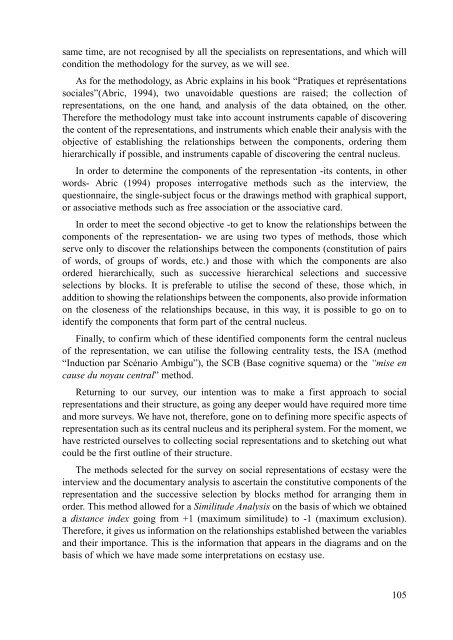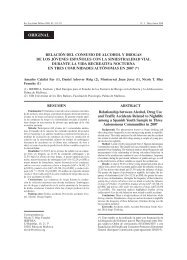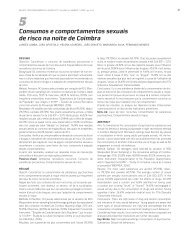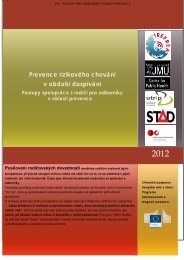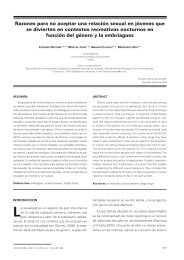Characteristics and social representation of ecstasy in Europe - Irefrea
Characteristics and social representation of ecstasy in Europe - Irefrea
Characteristics and social representation of ecstasy in Europe - Irefrea
You also want an ePaper? Increase the reach of your titles
YUMPU automatically turns print PDFs into web optimized ePapers that Google loves.
same time, are not recognised by all the specialists on <strong>representation</strong>s, <strong>and</strong> which willcondition the methodology for the survey, as we will see.As for the methodology, as Abric expla<strong>in</strong>s <strong>in</strong> his book “Pratiques et représentations<strong>social</strong>es”(Abric, 1994), two unavoidable questions are raised; the collection <strong>of</strong><strong>representation</strong>s, on the one h<strong>and</strong>, <strong>and</strong> analysis <strong>of</strong> the data obta<strong>in</strong>ed, on the other.Therefore the methodology must take <strong>in</strong>to account <strong>in</strong>struments capable <strong>of</strong> discover<strong>in</strong>gthe content <strong>of</strong> the <strong>representation</strong>s, <strong>and</strong> <strong>in</strong>struments which enable their analysis with theobjective <strong>of</strong> establish<strong>in</strong>g the relationships between the components, order<strong>in</strong>g themhierarchically if possible, <strong>and</strong> <strong>in</strong>struments capable <strong>of</strong> discover<strong>in</strong>g the central nucleus.In order to determ<strong>in</strong>e the components <strong>of</strong> the <strong>representation</strong> -its contents, <strong>in</strong> otherwords- Abric (1994) proposes <strong>in</strong>terrogative methods such as the <strong>in</strong>terview, thequestionnaire, the s<strong>in</strong>gle-subject focus or the draw<strong>in</strong>gs method with graphical support,or associative methods such as free association or the associative card.In order to meet the second objective -to get to know the relationships between thecomponents <strong>of</strong> the <strong>representation</strong>- we are us<strong>in</strong>g two types <strong>of</strong> methods, those whichserve only to discover the relationships between the components (constitution <strong>of</strong> pairs<strong>of</strong> words, <strong>of</strong> groups <strong>of</strong> words, etc.) <strong>and</strong> those with which the components are alsoordered hierarchically, such as successive hierarchical selections <strong>and</strong> successiveselections by blocks. It is preferable to utilise the second <strong>of</strong> these, those which, <strong>in</strong>addition to show<strong>in</strong>g the relationships between the components, also provide <strong>in</strong>formationon the closeness <strong>of</strong> the relationships because, <strong>in</strong> this way, it is possible to go on toidentify the components that form part <strong>of</strong> the central nucleus.F<strong>in</strong>ally, to confirm which <strong>of</strong> these identified components form the central nucleus<strong>of</strong> the <strong>representation</strong>, we can utilise the follow<strong>in</strong>g centrality tests, the ISA (method“Induction par Scénario Ambigu”), the SCB (Base cognitive squema) or the “mise encause du noyau central” method.Return<strong>in</strong>g to our survey, our <strong>in</strong>tention was to make a first approach to <strong>social</strong><strong>representation</strong>s <strong>and</strong> their structure, as go<strong>in</strong>g any deeper would have required more time<strong>and</strong> more surveys. We have not, therefore, gone on to def<strong>in</strong><strong>in</strong>g more specific aspects <strong>of</strong><strong>representation</strong> such as its central nucleus <strong>and</strong> its peripheral system. For the moment, wehave restricted ourselves to collect<strong>in</strong>g <strong>social</strong> <strong>representation</strong>s <strong>and</strong> to sketch<strong>in</strong>g out whatcould be the first outl<strong>in</strong>e <strong>of</strong> their structure.The methods selected for the survey on <strong>social</strong> <strong>representation</strong>s <strong>of</strong> <strong>ecstasy</strong> were the<strong>in</strong>terview <strong>and</strong> the documentary analysis to ascerta<strong>in</strong> the constitutive components <strong>of</strong> the<strong>representation</strong> <strong>and</strong> the successive selection by blocks method for arrang<strong>in</strong>g them <strong>in</strong>order. This method allowed for a Similitude Analysis on the basis <strong>of</strong> which we obta<strong>in</strong>eda distance <strong>in</strong>dex go<strong>in</strong>g from +1 (maximum similitude) to -1 (maximum exclusion).Therefore, it gives us <strong>in</strong>formation on the relationships established between the variables<strong>and</strong> their importance. This is the <strong>in</strong>formation that appears <strong>in</strong> the diagrams <strong>and</strong> on thebasis <strong>of</strong> which we have made some <strong>in</strong>terpretations on <strong>ecstasy</strong> use.105


